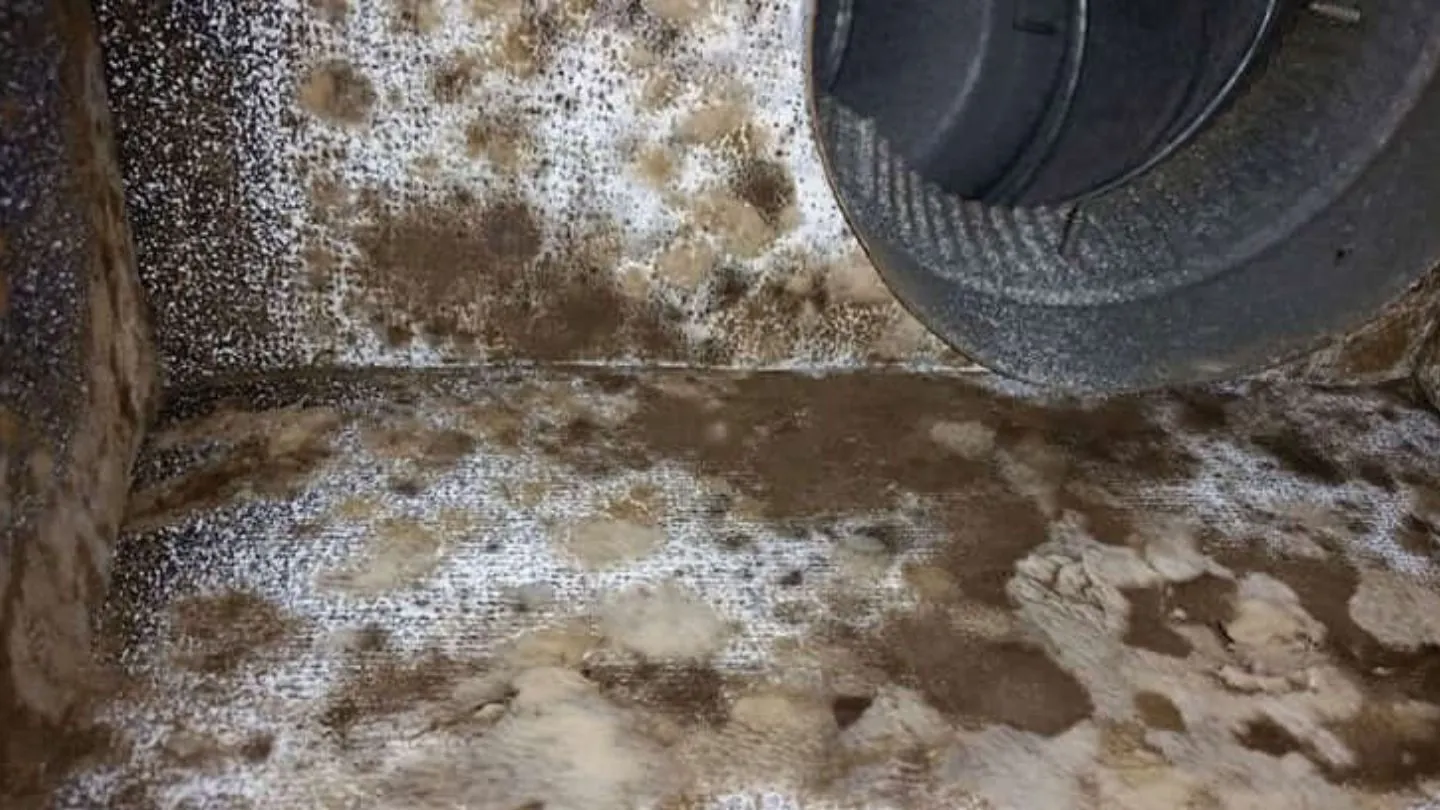How to Prevent Mold in HVAC System?
Mold in HVAC systems can harm your health and home. Learn simple steps on how to prevent mold in the HVAC system and keep your air conditioning system well-maintained to regulate moisture levels and mitigate mold growth.
Key Takeaways
- Mold growth in HVAC systems is primarily caused by moisture, high humidity, and poor ventilation; maintaining humidity levels between 30% and 50% is essential for prevention.
- Regular maintenance, including cleaning drain pans, replacing air filters, and using mold inhibitors, is crucial to keep HVAC systems mold-free.
- Proactive measures, such as investing in dehumidifiers and professional duct cleaning, significantly enhance mold prevention and improve indoor air quality.
Understanding Mold Growth in HVAC Systems
Mold growth is commonly found in HVAC systems due to the presence of moisture, condensation, and inadequate airflow. Older air conditioners can create conditions conducive to mold due to moisture and insufficient airflow. The cooling process in HVAC systems can lead to condensation, which creates moisture inside the unit and can contribute to mold growth if not properly managed. Elevated humidity and levels of moisture are critical factors that support mold proliferation within these systems. The process where an evaporator coil within air conditioning units pulls moisture from the surrounding air may result in mold formation if this collected water does not drain appropriately.
The collection of dampness in the ductwork of HVAC setups fosters a perfect setting for mold to flourish. A lack of proper airflow can cause a buildup of moist conditions, which encourages the development of mold within these systems. Recognizing such contributing elements is vital for devising efficient measures aimed at preventing mold emergence and ensuring a well-functioning HVAC system.
The Role of Humidity in Mold Growth
Maintaining humidity levels within the 30% to 50% range is crucial for mold prevention in HVAC systems. Air conditioners, especially older models, can contribute to humidity issues if not properly maintained. Keeping the indoor humidity below 50% is essential to inhibit mold development. Excess moisture can lead to mold growth, posing health risks and damaging property, making it important to manage moisture levels effectively. Devices like hygrometers enable close monitoring of indoor humidity, alerting occupants about potential conditions that could promote mold formation. Integrating a dehumidifier into an HVAC system ensures that moisture levels stay at optimal conditions, mitigating the risk of mold.
If humidity exceeds these recommended limits, it sets up an environment conducive for mold spores to thrive and multiply rapidly. Taking charge of indoor moisture and managing excess dampness plays a significant role in circumventing future issues related to molds.
By vigilant tracking and regulation of ambient moisture levels, one can effectively combat condensation accumulation, which deters the presence of airborne spores seeking moist spots to settle. Practical approaches such as deploying dehumidifiers paired with precise monitoring via hygrometers are instrumental strategies contributing towards successful ongoing efforts against preventing mold growth within HVAC setups.
Condensation and Its Impact
Moisture present in the air and the cooling operation of an HVAC unit can lead to condensation. Moisture can accumulate in air ducts, potentially leading to mold growth if not properly managed. If this condensation is not properly managed, it may cause malfunctions within the system as well as accumulation of standing water. Standing water within components of an HVAC system creates ideal conditions for mold growth. This situation often arises from blockages in the condensate lines or when drain pans are unable to effectively expel water through a deep seal trap. To avoid these issues and prevent mold proliferation, it’s crucial to consistently clean out drain pans.
To maintain proper function and manage condensation effectively within an HVAC system, routine inspections and cleaning are necessary for all its parts. Homeowners should pay special attention to keeping their system’s condensate pan and lines free from any obstruction. Dealing with clogs swiftly is vital. Such diligent maintenance significantly diminishes the potential for mold development, ensuring that your heating, ventilation, and air conditioning (HVAC) systems operate efficiently without interruption due to moisture-related complications.
Importance of Proper Ventilation
Inadequate ventilation results in the buildup of stagnant air and increased levels of moisture. This still air contributes to an environment conducive to mold proliferation. Enhancing indoor air quality involves ensuring that vents are free from blockages, which can be achieved by repositioning furniture or other items impeding airflow. By keeping vents unobstructed, HVAC systems function efficiently, circumventing the accumulation of moisture and thus inhibiting mold growth.
Securing proper airflow through effective ventilation is critical for averting the development of mold within a home while promoting a wholesome living atmosphere. The presence of fresh air circulation, along with diminished dampness, offers unfavorable conditions for the survival and spread of mold spores. Consistent upkeep and servicing of one’s ventilation system are fundamental practices in upholding adequate airflow as well as preserving superior indoor air quality—measures that collectively endorse a healthier domestic space.
Essential Maintenance Tips to Prevent Mold

Regular cleaning and inspections are crucial to keeping HVAC systems mold-free year-round. Cleaning HVAC vents and units regularly helps prevent mold by eliminating potential growth areas. Proper drainage prevents moisture accumulation that can lead to mold development.
Regular cleaning and servicing of air conditioning systems are essential to prevent mold growth. Maintaining air conditioners helps ensure efficient cooling and prevents issues like mold developing in different components. Proper drainage prevents moisture accumulation that can lead to mold development.
Regular HVAC upkeep is essential to prevent mold issues. Following these maintenance tips helps prevent mold growth and maintain a healthy HVAC system.
Regularly Clean and Inspect Drain Pans
Ensuring the cleanliness and upkeep of drain pans is crucial for eliminating standing water that could lead to mold development. Undertaking maintenance tasks specific to each season, which includes inspecting and cleaning drain pans, contributes to averting mold proliferation. Conducting consistent examinations confirms the cleanliness and operational status of the drain pans, while expert assessments offer comprehensive evaluations designed to prevent complications associated with mold in these components.
Incorporating routine cleansing and scrutiny of drain pans into HVAC system care practices is essential. This straightforward measure aids in preventing the accumulation of water as well as the potential growth of mold. Maintaining unobstructed drainage areas by removing debris helps mitigate risks connected with mold challenges, also promoting optimal functioning within HVAC systems.
Replace Air Filters Frequently
Replacing air filters at least once a month effectively traps mold spores. Regularly cleaning or replacing air filters keeps the air fresh and enhances HVAC efficiency. Regular air filter replacement prevents mold growth in HVAC systems and ensures clean indoor air.
Frequent air filter replacement maintains indoor air quality and prevents mold growth. Clean and functioning air filters trap mold spores and pollutants before they circulate through the HVAC system. This practice improves air quality and extends the life of the HVAC system.
Read more: Best Types of Air Filters for HVAC Systems
Use HVAC Mold Inhibitors
Mold inhibitors in HVAC systems effectively prevent mold growth. Applying mold inhibitors during maintenance ensures optimal HVAC performance and reduces mold risk. Regular use of mold inhibitors enhances HVAC longevity and ensures cleaner indoor air.
Mold inhibitors are valuable in preventing mold growth. Incorporating these products into regular HVAC maintenance provides extra protection against mold. Mold inhibitors keep HVAC components clean and free from mold, improving indoor air quality and system efficiency.
Advanced Solutions for Mold Prevention

Utilizing cutting-edge technologies can markedly improve the prevention of mold growth within HVAC systems. Selecting and maintaining appropriately sized air conditioners is crucial to prevent excess moisture and mold development. It is vital to engage a reputable HVAC service provider for routine maintenance, which includes regular inspections and cleaning as key strategies in thwarting the development of mold.
By adhering to recommended cleaning schedules that take into account both the age of your system and air quality, professional duct cleaning services contribute effectively to mold prevention. To guarantee comprehensive coverage during an HVAC cleanup, enlisting a skilled technician is advised. A knowledgeable professional will be able to identify potential problem areas, such as moisture accumulation or inadequate ventilation, and take proactive measures to address them.
1. Invest in Dehumidifiers
Whole-home dehumidifiers control moisture throughout the home to prevent mold. Portable dehumidifiers reduce humidity in one area, while whole-home units manage moisture for the entire house. Controlling indoor humidity prevents mold growth in HVAC systems.
Dehumidifiers help reduce moisture in key areas of the home. Investing in a dehumidifier helps maintain optimal humidity levels, reducing the risk of mold growth in HVAC systems. This investment improves indoor air quality and promotes overall home health and efficiency.
Read more: Air Conditioner Leaking Freon: 4 Causes Refrigerant Leaks
2. Install Ultraviolet Air Cleaners
Ultraviolet air cleaners harness the power of UV light to render mold spores inactive, thereby generating fresh air that’s suitable for breathing. These devices ensure that the air you breathe is clean and uncontaminated.
By incorporating ultraviolet air cleaners into HVAC systems, one can substantially improve indoor air quality through the eradication of mold spores and various airborne impurities. This innovative approach serves as an effective defense against the proliferation of mold, fostering a healthier living space within your home.
3. Professional Duct Cleaning
Professional duct cleaning is designed to eradicate existing mold and thwart potential future growth within HVAC systems. This process eliminates both mold spores and allergens, thereby improving the quality of indoor air and contributing positively to health. To achieve effective prevention against mold, it’s advisable to arrange for certified HVAC experts to clean the ducts periodically.
Engaging in regular professional services from HVAC specialists for duct cleaning guarantees a comprehensive cleanse of all components in the system, keeping them devoid of any traces of mold. Such meticulous maintenance not only improves the air quality indoors but also serves to prolong the operational lifespan of your entire HVAC system.
Committing funds towards expert duct cleaning aids in avoiding issues with mold while promoting an overall healthier environment within residential or commercial spaces.
Identifying and Addressing Mold Issues Early

Speckles on air registers and musty odors often indicate mold in HVAC systems. A certified HVAC company can help identify mold problems in your system. If mold issues arise, keep a watchful eye on signs of growth. Mold can hide in HVAC components and remain microscopic, making it difficult to detect.
Regular inspections can identify potential mold growth in HVAC systems early. Routine inspections of ductwork for mold spores are crucial, especially after mold treatment. Regular professional duct cleaning removes existing mold and prevents future growth. Ignoring mold in HVAC systems can lead to costly damage.
Signs of Mold in Your HVAC System
Detecting mold in your HVAC system early is crucial for maintaining a healthy indoor environment and ensuring efficient system performance. Mold can often go unnoticed, but there are telltale signs that homeowners should be aware of to address the issue promptly. Here are some common indicators of mold presence in your HVAC system:
- A persistent musty smell, often signaling hidden mold growth.
- Visible mold that may appear in colors such as black, green, or gray is typically found in moist areas.
- Frequent allergic reactions or respiratory issues among household members.
- Unusual humidity levels or condensation around the HVAC system.
- Mold spots or discoloration on air registers and vents.
Recognizing these signs allows homeowners to take swift action, preventing further complications and promoting a healthier living space.
Steps to Safely Remove Mold from Your HVAC System
Addressing mold problems in HVAC systems requires the expertise of certified professionals who are equipped with the right tools and knowledge. Relying on professional services ensures safe and effective mold removal:
Step 1: Engage Certified HVAC Professionals: Before any mold removal process begins, it’s crucial to consult with certified HVAC professionals. They possess the necessary protective gear and expertise to handle mold exposure safely. Professionals use EPA-approved mold cleaning agents and advanced tools for thorough cleaning.
Step 2: Comprehensive System Cleaning and Disinfection: Professionals meticulously clean and disinfect the affected areas of the HVAC system, ensuring all components are treated to eliminate any mold spores present. Their expertise guarantees a thorough and effective cleaning process.
Step 3: Application of Mold Inhibitors by Experts: After cleaning, professionals apply HVAC-specific mold inhibitors to all parts of the system. This step is crucial for preventing future mold and mildew growth, and professionals ensure the inhibitors are applied correctly for maximum effectiveness.
Step 4: Proper Disposal of Contaminated Materials: Certified professionals handle the disposal of used materials, such as cloths and brushes, in compliance with safety regulations to prevent mold from spreading.
Step 5: Regular Professional Maintenance and Seasonal Routines: For severe mold infestations or ongoing prevention, scheduling regular maintenance with a certified HVAC professional is advisable. They provide comprehensive mold removal services and ongoing support to prevent future occurrences, ensuring healthier indoor air quality.
To further thwart mold within your HVAC system, engage in seasonal upkeep. During summer, focus on air conditioning units to maintain cool, clean air and reduce mold risks. As autumn arrives, shift attention to furnaces and ductwork to prevent mold before winter. This proactive approach ensures efficient operation across all seasons, minimizing potential mold issues.
Monitoring Indoor Humidity Levels
Common sources of increased humidity indoors include indoor showers, baths, and saunas. Monitoring indoor humidity levels is crucial for preventing mold growth, as mold thrives in damp environments. Maintaining indoor humidity levels between 35-50% helps minimize the risk of mold formation in HVAC systems.
Using humidity monitors allows for timely adjustments to the indoor environment, helping to maintain optimal humidity levels. Keeping an eye on indoor humidity levels is a simple yet effective way to prevent mold.
By using humidity monitors and making necessary adjustments, homeowners can create a less hospitable environment for mold. This proactive approach ensures a healthier home and a more efficient HVAC system.
Ensuring Continuous Airflow
When you’re not at home, keep your air conditioning in ‘auto’ mode to maintain a steady flow of air and reduce the potential for mold development. Not using the air conditioner when away, such as during vacations, could lead to an accumulation of moisture, which provides a perfect setting for mold spores to thrive. Ensuring that HVAC systems have proper airflow is essential in preventing mold growth.
It’s critical to keep mold at bay within HVAC systems by guaranteeing there’s a constant circulation of air. By doing so, it helps lessen the chance of dampness forming and stops mold spores from finding places to settle down and grow. Simple steps like activating the A/C unit’s ‘auto’ function can be quite effective in sustaining an environment devoid of mold.
Summary
To thwart mold growth within HVAC systems, a thorough strategy is necessary. This includes grasping the origins of mold proliferation and applying critical maintenance practices, along with adopting sophisticated methods. By monitoring humidity levels, handling condensation adeptly, securing adequate airflow through proper ventilation, and adhering to consistent upkeep schedules, residents can markedly diminish the incidence of mold issues. The employment of apparatuses such as dehumidifiers alongside UV air purifiers coupled with routine professional duct cleansing sessions amplifies efforts in preventing mold.
These preventive measures safeguard not just the heating and cooling system but also contribute to preserving a salubrious living space for you and your kin. If you require expert guidance or dependable services in maintaining your HVAC unit(s), engaging with Total Comfort Cooling & Heating Inc. for HVAC services in Boca Grande may prove beneficial. We, as a team of skilled technicians, stand ready to maintain your HVAC appliance in pristine condition all year long—warding off potential concerns related to mold infestation while ensuring optimal function. Contact us today to prevent mold growth in your space!
Frequently Asked Questions
Why is it important to control humidity levels in my home?
Controlling humidity levels in your home is essential to prevent mold growth that can harm indoor air quality and pose health risks. Maintaining optimal humidity ensures a healthier living environment.
How often should I replace my HVAC air filters to prevent mold?
To ensure clean indoor air and effectively trap mold spores, it is essential to change your HVAC air filters at least monthly. Regular maintenance can drastically lower the chances of mold growth.
How can I tell if there is mold in my HVAC system?
To determine if there is mold in your HVAC system, look for musty odors and visible mold on air registers. Seeking professional help is recommended for accurate identification if you suspect mold.
Why should I schedule professional duct cleaning for my HVAC system?
Scheduling professional duct cleaning for your HVAC system is essential for improving indoor air quality by removing mold spores, allergens, and pollutants. This proactive step helps prevent future mold growth and ensures a healthier living environment.
READY FOR YOUR NEXT HEATING OR COOLING PROJECT?
Contact us to get a quote and see why our customer service is recognized as the best in the industry.







 Special Offer: 12 Months - No Interest, No Payments!
Special Offer: 12 Months - No Interest, No Payments!